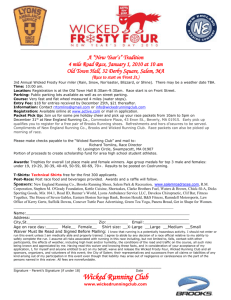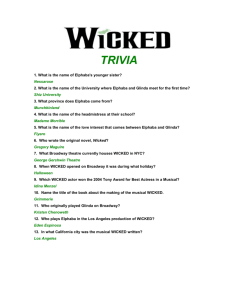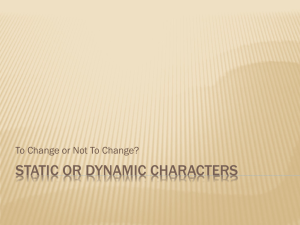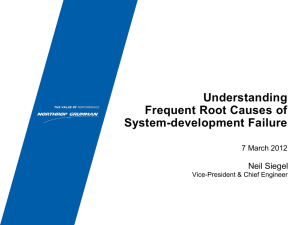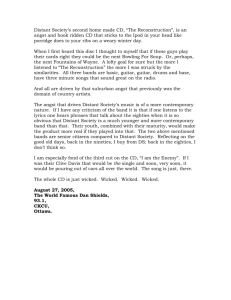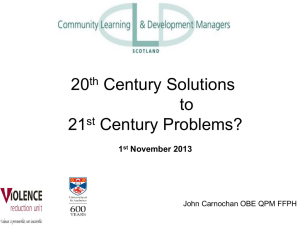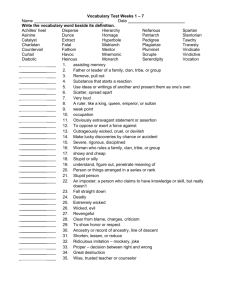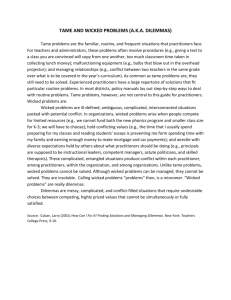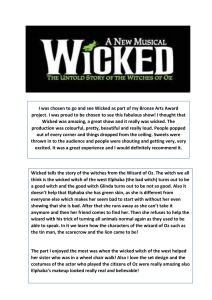Document 10950234
advertisement
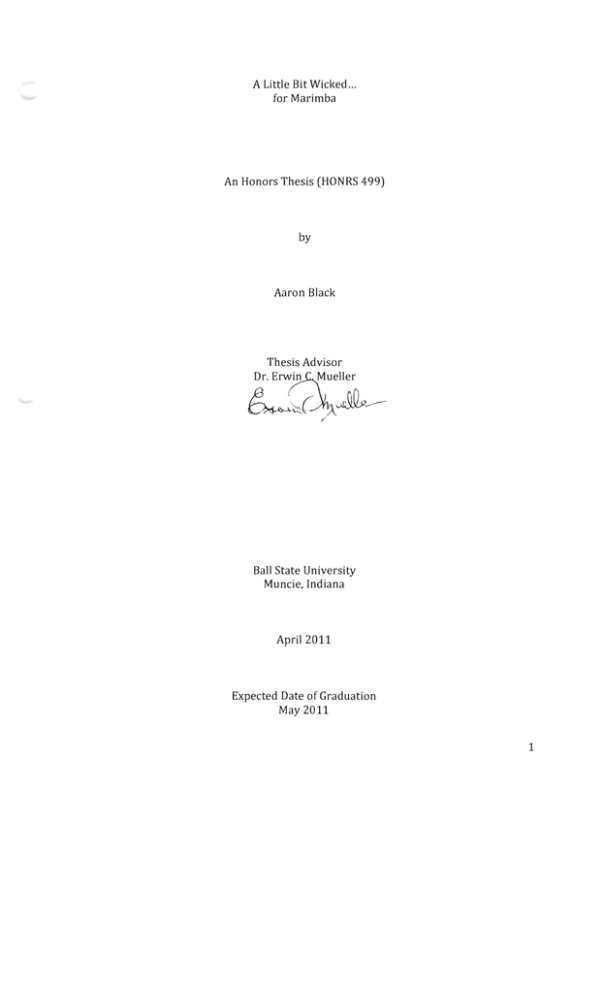
A Little Bit Wicked ... for Marimba An Honors Thesis (HONRS 499)
by
Aaron Black
Thesis Advisor Dr. Er~.M
MUfuelJer
~~.~(~~~.--/
BaIl State University Muncie, Indiana April 2011
Expected Date of Graduation May 2011 1
'/
• J
Abstract
Marimba c~mpositions in the last 20 years have become more and more complex in nature,
almost to the point of absurdity. When a former student of mine commissioned me to write
her a marimba piece, I gladly accepted. I set out to write a marimba piece that while being
easily accessible by the common listener, would also find its place among the more abstract
pieces in a musical library. I also kept in mind the player I was writing for and the
interactions we have had over the years by including several musical quotes from music we
worked on together. The finished piece embodies the characteristics of a new twentieth­
century work while keeping the personal aspects of an older more familiar selection for
both the player and the audience.
Acknowledgements
I would like to thank my advisor Dr. Erwin C. Mueller for helping me with not only this
project, but also my quest to become a better musician and human being. His impact on my
life is enormous and I will never be able to fully repay him for all he has done for me.
I would also like to thank the commissioner of the piece, Miss Amy Humrichouser. Her faith
in me both as a teacher and a composer is humbling.
Lastly, I would like to thank my wife for helping me with the editing process of this work
and being with me through both the good and the bad.
2
In writing A Little Bit Wicked, I decided to make the whole piece roughly based on a
marching band show that both the commissioner (Amy Humrichouser) and I worked on in
the summer of 2008. Miss Humrichouser was a student at Danville Community High School
in Danville, Indiana, and I was a front ensemble teacher during that season. The show was
designed around the musical Wicked. I never heard the original music until a few days
before camp; the second I heard it, I was thoroughly enthralled. It was perhaps one of the
most memorable summers I have ever had working with a group, so it only seemed natural
to make it the basis for the composition.
There are several other musical quotes located within the piece, however the
overwhelming feeling of the work is Wicked based. The first three notes of the piece are a
selection of the vocal line for, "Defying Gravity," as shown in example 1. I chose to have
them rolled at a mezzo-piano dynamic level because it made the opening feel like the end of
a memory fading away. This fragment comes back repeatedly in the piece, helping not only
the cohesiveness of the work, but also the overall message I was trying to convey.
dtr
.>
14'
r Iii
1 CF 0
f
,
• I
IT'
;)
r,)J/
!- 1
1- -
!p.-.#---I
i
'
J
IF J 4
1
>
-•
r.
'1
I
J
1
-" ,
.•
I
~,
J
Ex. 1 Top line is the main melody to "Defying Gravity"; Bottom line is first measure from A
Little Bit Wicked ...
3
The next section of rolled chords is half original composition and half my own creativity
at work. The opening statement of a 9-8 and 4-3 suspension above a major chord is actually
from another show I worked with Danville and Miss Humrichouser on in 2009. The
movement following bar 2 is of my own creation and also comes back at tension points
during the rest of the piece. Along with the original three-note motif, this section is the glue
that holds the piece together. Following the rolled chords is another Wicked fragment
starting at bar 10. This time the fragment is from the end number of the musical entitled
"For Good."
.>
j ..
,
r
1-
•
I
•.
!
J
TI
I
--
.-J ,
~
';,
J ) ~J
=:E
-L-
Ex. 2 Top line "For Good" melodic fragment; Bottom line A Little Bit Wicked ... bars 11 and
12.
The following section from bar 13 to bar 20 was inserted into the piece by request from
Miss Humrichouser. It was originally composed for the aforementioned 2009 Danville
Show and was considered a marimba 1 soli. Miss Humrichouser worked extremely hard on
the section and requested it be inserted into the work. The difficulty of this section comes
from not only the mallet permutations, but also from crossover technique that is required
4
as shown in example 3. Bars 21 and 22 are similar in technique to the previous bars,
however they were not present in the original arrangement of the piece. I consider them
transition permutations to the 6/4 bar at measure 23. The 6/4 bar serves two functions:
First, it provides a conclusion to the previous section by landing on a four mallet block
chord, and second it presents an economical and musical way for the performer to get
down to the frame of the marimba.
I : iJ
!
r
Ex. 3 The notes in the upper staff indicate the left hand crossing over the right to play.
When Miss Humrichouser asked me to compose this piece, the next section was one of
the original concepts 1 knew I wanted to use. Many mallet pieces make use of alternative
ways to strike the bar to create different timbres; however, I have yet to come across a
piece that used the frame of the marimba as a drum. I decided to try and implement this
sort of playing into the work by quoting a snare lick from the original 2008 Wicked show as
shown in example 4. The next section at bar 26 makes use similar material; however, the
introduction of a muted 'A,' which is the lowest bar on a 4.3 marimba, appears as well. The
two against three feel was meant to give the piece some metric tension as it was
approaching an arrival point.
5
L.
.
w;;
,, •
-~
;;
I
i
I'
,
i
).
7
'}
================~~--tI-
I
l
~-
I~
Ex. 4 Top line original snare lick; Bottom line from A Little Bit Wicked ... bar 24.
The metric build continues until bar 32 where another quote from the Wicked show
appears along with battery hits beneath it as shown in example 5. This section is one of the
more difficult in the piece, as it requires the hands to have rhythmic independence from
each other. The section it quotes from the 2008 show is one of the high points of the first
movement, containing both a rhythmic and melodic arrival point. The melodic material
here pushes into the cadenza at bar 39.
,..
....
•
)
"
f
,
--i
,
,..
~
I
7'
7
,
•
I
I
Ex. 5 Upper line is original snare lick; lower line is from Little Bit Wicked ... bars 32 and 33.
The cadenza was built almost entirely of fully diminished chords arpeggiated up and
down the keyboard . This section of the music has no meter defined for it, as it is to be
played in a more free flowing fashion. This section was meant to show off the performer's
abilities more than anything else. The final run up the keyboard in bar 43 serves two
6
purposes: it finishes out the cadenza phrasing, and it places the player high up on the
keyboard, which is where the next section begins.
The original rolled chords that appear at the beginning of the piece make another
showing at bar 44 in an altered form and higher on the keyboard as shown in example 6.
The sound of the keyboard in the upper register required a variation from the original
progression to achieve a similar feel. Also, because the player is rolling chords in the upper
level of the keyboard, it requires her hands to move at a much faster rate than if they rolled
in the middle or lower portion of the instrument. This faster motion for the same amount
of sound gives the music more tension, despite the fact that the dynamic level is at piano.
I
B
Q
}­
~q
;b
-r
d
I
.
;:1
-~
~ ,'1
t
~"
,c
5
,,--'"
Ex. 6 Upper line original statement of rolled chords; bottom line varied statement
Again at bar 54 we find the three-note motif from the beginning of the piece making an
appearance. It leads us into the next section that takes several chords from another piece I
7
wrote and uses them to transition into the last section of the piece. The portion of music
from bar 55 to bar 65 is supposed to gradually accelerate and grow in volume until it
arrives at bar 66. At bar 66 we have two new items that signal a significant change in the
piece: the new meter and the new key. Here, the music shifts from a relatively duple feel to
a definite triple feel, while the key changes from a variation on Eb to a definitive E major
feel.
The ostinato at bar 66 is taken directly from the song "Defying Gravity." This pattern
appears repeatedly throughout the song and is one of the identifying characteristics of the
piece; using it only seemed natural. The three-note motif appears on top of the ostinato at
bar 67 and 71, however, this time the motif is actually used as the melody to the song it was
borrowed from, "Defying Gravity." The piece moves forward until it reaches the 18/8 bar
and finally arrives at a variation of the main them to "Defying Gravity" at bar 77. This
statement leads the piece into the final statement of the rolled chords, this time varying the
right hand by making the intervals sixths instead of thirds. The last few notes played by the
performer are the three-note motif adding an F at the end, giving a feeling of finality to the
piece.
This piece was supposed to be performed sometime during the month of February by the
commissioner, Miss Humrichouser. However, due to time constraints, she was not able to
do so and no recordings of this piece exist yet.
8
Works Cited
Gilroy, Gary. Fire & Ice. Gary P. Gilroy Publications, 2009.
Morse, John. Wicked Marching. Morse Publications, 2008.
Soundheim, Stephen. Wicked: A New Musical. Decca Broadway, 2003.
9
'."
f.vb~ t ...>
,,':(tJcI "
I
~- (,
...
(j)
')
--­
.
"
,
1\
11)~i~/
/ i
111'
"
(
.J),}
-­
!
I
\!
:,
- ;
V
/:, j 'N' 'I:.J
I
J-: 'iJ .-;­
.
'L
./
i]
r;.
1_
-,.
./
J
J.
7
i- \
)
I.
/
I
./
I
1
I
(I:
()
./
___J
\../
,["
r---~'- ---
"i
..,.. i
"t
.
'i
i
c.,.·
I
i
r
'"
T;
."-
C te) ,
/'
i
I
I~
t.
1 -:- ­
..;. 1
"
tI
,..I
. .,:'.;/ '
. -::::::::::J­
/' . <
.: .. /
;J
. /1
;
.
!.
,
-1-#
;
\
i
\
/
T
-I'
I
p­ "
i
1
I
,1 f¥>
(2) -, I
,,- .. --,- ~
1- -
..
_(
'
.,
.
-
- 1
_L
~l
..,
~
T -.
-.'-
f
f
. , j.
.I
k ..
'/ ., ",I' ,
:r
·
:I , J
~.
!}
.i
f
,
f
'.
('
/:. - H - .
. .
- --.. "'--_ .
.-....:.---
-'- '---
-
.. . .
--.:.-.-~.---
.!
/.
/'.
/­
.Ll
~
-.~
/
. I
;_
\
-r
-_. _ ---------­
y'
..... , -
,...
--.~
-- "­
,J
\
II
.
y 'i
'/
,,
,,\
•,
L
)'
1: .
1
.
)
I
..
) .
.}J'
,
i
I
~ :
OJ'.
\
H
.-
r
,........
"
#
.
q •
=
-
~
jor
or J'
!-: 1I
7
-
~
,-
:t, ..,.
/
I
I
')
r-
I
~
; .
j ,..' :.
..
{J
r
2
,<
r
.i
A
i i
.1 ! J
I
,"
"
------~
. ---.­
'---'
--,;:.p
,
I ~_ .•. f_ t
~-,"
! ~1
7
r­
f.l1 "'t ~.
'1
(
rtp
I
.~ '
i
.r)
r
. .A
'3 , f
:,/
I
I
r
"(
}~--~ .
I
r
("
I
.J
t /.,
I
L
)
/.'
t
('
I
l'
\ 1
l_
r \,..
,
,
I
;: :1
I
;
:<'
. ." I
'-:1
(!
..
.1
, ,' ';
!
\,
I
"
)-:, "J
.
.
~r
--- ---,
­
'- ,, --
I
-i \
.
.#.-­
_ ,
--
r
11" (.
If/•.
/';
fY 'Jt-j
.,.C
,
,
•
I t _u
./
'i5
- ----.-
·t. · ..
;
/
.
h
,
.., ,'
..­
~ . ;"' -:::: l
~ .-~ ~
I
\
(J
I (
.
G
(')
(.
... '
{
,
"
.
!
­ ." /
., .
.J
: y
,:
''./
.017
h ffL
II
':.- ;L
'{ v-t: "
/'
/
'.­
I
r - _ ~;-,..b:::.::l-
,el
·... t .·
~o
".,
_¥~
~~~
____
~"~-+~
'
____
~~,-
!I
/'
'f
____
~
________________________
~~.-
__________________
~'~r
___________________
(
.a.~ -'
'
I
.Jj'
I
'1
_ ,-. ---"::-"
I
··--r
r
'..'
--fnj
I
"
,- ','
'
","
J.
1
,~
.,
..r'
I
-
1
I
,
, -<--
:,.-
.
C{ c, <..
'
,I
<I>
I.U
'
•,
'",
:"
~'\
;')
\,
// '
,.
"
- '-
~ I
--I
I
~
\
-- I
1
..
·f
(jo-
-.
.....
,,>
,
- \"
Jele) - I .:,.)
/
{'
,?
'z ~~~
'......
All
•
1-.
"",.
I,'.
-.--:- ­
f; 1 .,.-; / ..
,
,.
.i
1
' 0,'
.111 '
'\
b-
v
I
­
.... ......
v
- -, CJr oc:-d
()
I
I
,;
7
\\
11
; i
!\.,
",.
G
,
""
0
f:j
e
~
"6
0
G--
f/ ,
}-'
----..:::::c­
!\
"~I
4-,'
)
!;I~
" '::1
irl~!
~
i'
:.v
A
y
'"
3 ·­
. :y:
"'"
. 1~
t~
.I Ii
T
-,
T
'/
'i \"
.
y ~
